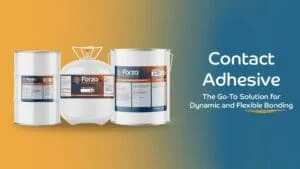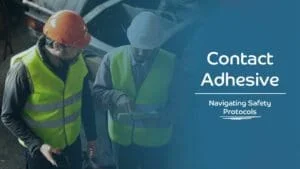Contact Adhesive: The Go-To Solution for Dynamic and Flexible Bonding
What Are the Key Benefits of Using Contact Adhesive?
- Superior Flexibility: Ideal for materials that experience movement or temperature changes.
- Diverse Material Compatibility: Effective with a wide range of non-porous materials.
- Resilient in Challenging Environments: Maintains strong bonds under stress, temperature variations, and moisture.
- Ease of Application: Perfect for large or irregular surfaces, reducing preparation time.
Forget the basics of contact cement; let’s talk about contact adhesive. This isn’t just another type of glue; it’s a game-changer in the adhesive industry. While it shares the principle of creating strong bonds like contact cement, contact adhesive is in a league of its own with its unique features and wide range of applications.
In the world of adhesives, understanding the difference between types is key. We’ve already covered contact cement, which is great for its strength and perfect for non-porous materials. Now, we’re focusing on contact adhesive, known for its outstanding flexibility and resilience. This is your go-to adhesive for scenarios where materials are constantly moving, expanding, or dealing with various environmental conditions – places where the rigid strength of contact cement just won’t cut it.
Here, we’ll dive into what makes contact adhesive the top choice for many applications, from automotive repairs to crafting. It’s robust yet versatile, handling everything thrown its way with ease.
Distinctive Characteristics of Contact Adhesive
What sets contact adhesive apart? Here’s the rundown:
- Superior Elasticity: It stays flexible, handling movement and temperature changes like a pro.
- High Tolerance for Different Conditions: It thrives in moisture or fluctuating temperatures.
- Versatile Material Compatibility: It sticks where others fail, especially with non-porous surfaces.
Specialized Applications of Contact Adhesive
Where does contact adhesive shine?
- Repairing Flexible Materials: Think rubber hoses or outdoor gear.
- Crafting and Art: It’s strong yet flexible for custom creations.
- Industrial Uses: Ideal for bonding materials in hot or cold environments.
The Edge Over Other Adhesives
Why choose contact adhesive?
- Tough in Harsh Environments: It stays bonded under stress and varying conditions.
- Easy Application for Tricky Surfaces: Perfect for large or odd-shaped materials.
- Quick Prep Time: Bonds on contact, saving you time.
Durability and Flexibility
Contact adhesive isn’t just strong; it’s built to last:
- Long-Lasting Bond: It resists wear and tear like a champ.
- Flexibility Under Pressure: Ideal for materials that move or expand, keeping the bond solid.
Eco-Friendly and Safety Innovations
The latest in contact adhesive technology:
- Low-VOC Formulas: Safer for indoor use and better for the planet.
- Non-Flammable Options: Increased safety in various applications.
Contact Cement vs. Contact Adhesive
Here’s the lowdown:
- Contact Cement: Best for strong, immediate bonds on rigid materials. Not so flexible when dry.
- Contact Adhesive: The choice for flexibility and resilience in situations with materials that might bend or stretch.
Health and Environmental Considerations
Using contact adhesives responsibly:
- Health Safety: Always ensure good ventilation and use protective gear to avoid fume exposure.
- Environmental Impact: Opt for eco-friendly choices and dispose of containers properly.
Innovative Applications and Future Trends
What’s next for contact adhesive?
- Cutting-Edge Research: The industry is constantly pushing for stronger, more sustainable options.
- Creative Potential: Its versatility opens doors to new uses, from art to practical innovations.
Conclusion
To wrap it up, contact adhesive isn’t just versatile; it’s a powerhouse in flexibility and resilience, making it invaluable for both industrial and personal projects. With ongoing advancements in safety and environmental friendliness, its future looks even brighter.
But we’re not done with adhesives yet. Next up, we’re tackling safety protocols for using contact cement and adhesive. Stay informed about safe practices and usage tips to make your projects successful and secure.
Stay tuned for more, and for a comprehensive range of adhesive solutions, check out Forza Built. Need advice or a specific quote for your project? Contact us for expert guidance and the perfect adhesive solution.
Join us as we continue exploring the complex world of adhesives, ensuring your projects excel in both quality and safety.
FAQs About Contact Adhesive
What is Contact Adhesive?
Contact adhesive is a versatile and dynamic adhesive known for its elasticity and resilience, making it suitable for various applications where materials undergo movement, expansion, or exposure to different environmental conditions.
How Does Contact Adhesive Differ From Contact Cement?
While both are used for quick bonding, contact adhesive is more flexible and resilient, making it ideal for materials that may bend or stretch. Contact cement, on the other hand, is better for rigid, non-porous materials and is less flexible once cured.
What Are the Primary Uses of Contact Adhesive?
It is widely used for repairing flexible materials like rubber hoses and upholstery, in crafting and creative arts, and for specialized industrial applications where thermal expansion is a factor.
What Makes Contact Adhesive Unique Compared to Other Adhesives?
Its superior elasticity, tolerance to different conditions, and compatibility with a diverse range of materials set it apart. It’s particularly effective in challenging environments and difficult-to-clamp scenarios.
Is Contact Adhesive Environmentally Friendly?
Recent advancements have led to the development of low-VOC formulations and non-flammable options, making contact adhesives safer for indoor use and less harmful to the environment.
What Safety Precautions Should Be Taken When Using Contact Adhesive?
Adequate ventilation is crucial due to fume emissions. The use of protective gloves and masks is recommended to avoid skin and respiratory exposure.
How Does the Flexibility of Contact Adhesive Benefit Its Applications?
The flexibility ensures that the bond remains intact without cracking under stress or movement, making it ideal for materials that undergo expansion.
What Are Some Innovative Applications of Contact Adhesive?
Apart from traditional uses, contact adhesive is finding applications in artistic endeavors and practical inventions, with ongoing research focusing on more sustainable and stronger formulations.
How Has Contact Adhesive Technology Evolved Recently?
There is a shift towards creating more environmentally friendly adhesives with low VOCs and non-flammable properties, enhancing safety and sustainability.
Where Can I Find More Information or Get Advice on Using Contact Adhesive for My Projects?
For more insights and adhesive solutions, visit Forza Built. You can also reach out to them for personalized guidance and expert advice for your specific adhesive needs.
Can Contact Adhesive Be Used in Outdoor Applications?
Yes, contact adhesive is well-suited for outdoor applications due to its high resilience to temperature changes, moisture, and stress. Its durability makes it an excellent choice for repairing outdoor gear and other materials exposed to environmental elements. However, it’s important to select a contact adhesive specifically designed for outdoor use to ensure optimal performance and longevity.



